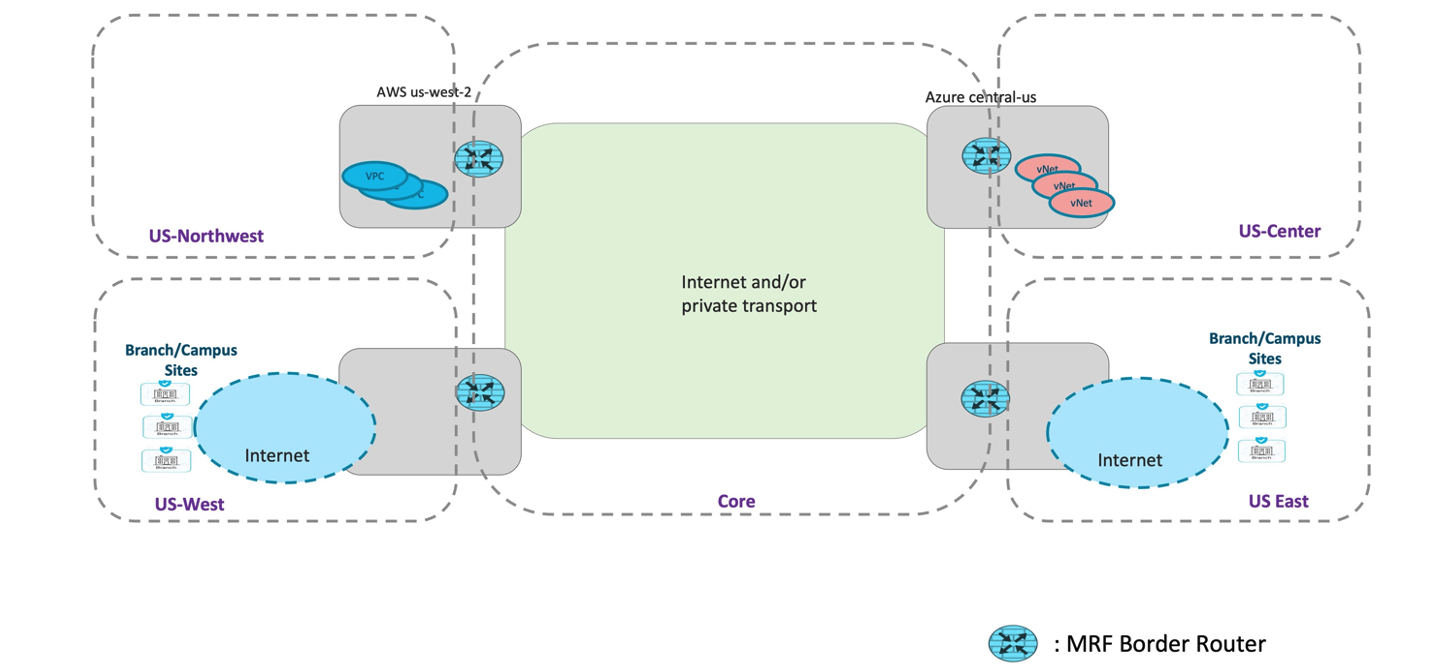- Cómo evitar la fuga de cerebros en TI
- Is ChatGPT Plus still worth $20 when the free version packs so many premium features?
- How this 'FinOps for AI' certification can help you tackle surging AI costs
- ChatGPT can record, transcribe, and analyze your meetings now
- 3 ways to streamline cloud adoption and cloud security
Cisco SD-WAN Multi-Region Fabric Unites Distributed Enterprises

Cisco SD-WAN Multi-Region Fabric (MRF) is designed to help IT build, deploy, and manage geographically distributed SD-WAN networks that provide resiliency, redundancy, security, and control. SD-WAN Multi-Region Fabric continues Cisco’s commitment to bringing networking infrastructure innovations that enable IT to support business-critical connectivity projects in a world of increasingly distributed people, applications, and compute resources.
Implementing an SD-WAN MRF also provides the ability for enterprise IT to select multiple premium transport providers for inter-region connectivity based on performance and cost. The premium transports can be mixed with best-effort public transport over the Internet to provide flexibility in reducing transport costs while ensuring that business-critical applications can use SLA-guaranteed premium transports as needed.
Architecting a Multi-Region Fabric with Cisco SD-WAN
Fundamental building blocks for an SD-WAN Multi-Region Fabric are logically distinct SD-WAN regions where people and applications reside and connections to those regions are maintained via a shared inter-region network. All inter-region connections are enabled via SD-WAN border routers. For redundancy and scale-out designs, multiple SD-WAN border routers can be deployed at each region boundary.
Enterprise IT has full flexibility in the choice of transports—premium middle mile, cloud provider’s backbone, MPLS, or Internet—for creating an inter-region network. Access regions can also selectively deploy Internet, MPLS, or LTE connectivity. Cisco SD-WAN automatically computes the most optimal paths across the multi-region network, avoiding the need to manually configure hop-by-hop routing policies, saving many hours of IT time, and avoiding configuration errors.
Path compute also automatically handles network failures and finds routes around them. Automated path selection can be programmed to selectively control paths taken by business-critical applications, providing extensive control over application experience and the corresponding transport costs. Adding new regions is seamless as Cisco SD-WAN automatically computes paths to and from newly added regions and propagates route reachability information, eliminating the need to manually configured route policies.
As shown in Figure 1, an example network is grouped into access regions (Region-1 US West and Region-2 US East) that are connected via a core region. With Cisco SD-WAN Multi-Region Fabric, IT has maximum flexibility in choices of topologies, transports, and encapsulation methods per region.
- Regional Topologies – It is possible to deploy a region with full mesh connectivity that provides optimal any-to-any connectivity, while in another region IT can choose to deploy a hub and spoke topology to provide centralized access to resources in a data center. A region may also selectively deploy on-demand connectivity with SD-WAN’s on-demand tunnels feature, enabling existing simpler routers to participate in large-scale mesh networks.
- Regional Transports – IT can selectively enable transports of varying costs and connectivity characteristics per region. For instance, some locations may optionally enable an LTE link in access regions, while others may simply decide to connect sites with Internet transport. The core region, which provides inter-region connectivity can also be built with any transport provider, including the new age middle-mile providers or a hyper-scale cloud provider’s transport backbone. These private transports can provide SLA-guaranteed region connectivity.
- Regional Encapsulations – Cisco SD-WAN leverages industry-standard IPsec encryption for ensuring the confidentiality and authenticity of traffic. For cases where this level of security is not required in a certain region, IT can also enable a less expensive encapsulation for SD-WAN tunnels, such as Generic Routing Encapsulation (GRE).
Build a Horizontally Scalable Routing Controller Architecture
As the scale of multi-regional networks continues to expand, Cisco SD-WAN Multi-Region Fabric provides an additional innovation of employing distributed SD-WAN routing controllers. Each MRF region can have its own set of routing controllers, providing the foundation for a horizontally scalable routing controller architecture. The distributed infrastructure provides resiliency against regional outages, where controller outages in one region will not affect other regions.
Scale Up with Multi-Cloud and Colocation Deployments
Cisco SD-WAN Multi-Region Fabric is intrinsically designed to enable multi-cloud deployments and colocation-based network architectures. Figure 2 illustrates a sample MRF deployment where the enterprise has IaaS workloads in AWS and Azure as well as campus and branch sites distributed geographically across the two US coasts.

Any number of Cloud Service Providers (CSP) regions can be enabled in the topology. In this example, two regions and two CSPs (Azure and AWS) are shown. It is also possible to deploy Software-Defined Cloud Interconnect (SDCI) enabled private transport in the core with MRF border routers in the SDCI points of presence or colocation facilities. The figure shows branch and campus sites in access regions, one or more of which could also be an on-prem data center.
Expand the Enterprise with Cisco SD-WAN
To keep pace with connectivity requirements for a rapidly evolving enterprise, the Cisco Multi-Region Fabric SD-WAN architecture enables:
- Secure, scalable, resilient, and geographically distributed WANs
- Regional choice of transports, topology, and encapsulation
- Intrinsically supports optimal hybrid cloud connectivity
- Enables IT to leverage software-defined cloud interconnects and premium middle-mile transports to maximize performance with balance economics
- Zero-touch optimal path compute across regions
For more information:
Deploy and Manage Networks Globally with Cisco SD-WAN Multi-Region Fabric
Cisco SD-WAN Multi-Region Fabric Video
Keep up with the latest in networking and get curated content from Networking experts at the Networking Experiences Content Hub
Share:

